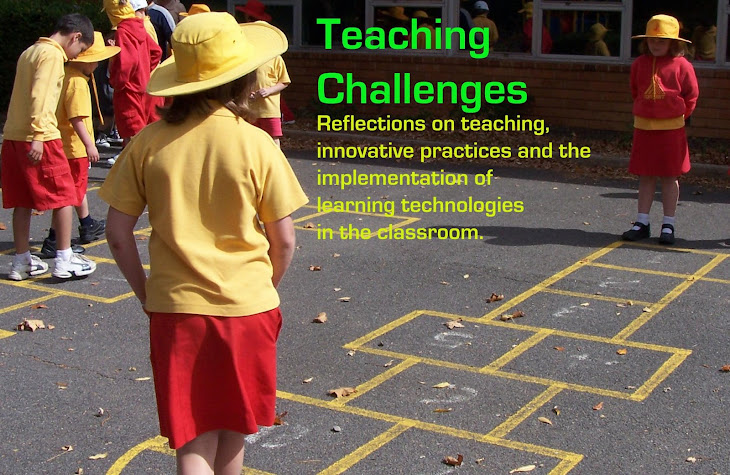
Today I would like to look at how regular physical activity and 'health breaks' can be used in the classroom to promote a healthy lifestyle.
One of the challenges of teaching is balancing all that needs to be done in order to create well-rounded students. We're in the business of educating students for life beyond the classroom. Part of this involves teaching them how to make lifechoices that will help them maintain health and fitness. I know from my experience teaching, that this is an area often pushed to the side in order to ensure that the kids can read and write properly, or complete the Maths program.
In recent years, I have seen the 'fruit break/health break' idea being used more regularly in schools. As schools commit to a 2-hour literacy block in the morning, they are finding that students (particularly the younger ones) are getting hungry, and losing focus before they make it to the first scheduled meal break. Many schools have found that by taking a break mid-way through this morning session (for a piece of fresh fruit or vegetable, and a drink of water) students are exposed to healthy eating and are able to continue for the rest of the session. I have been aware of this being done in a couple of different ways:
20 minute Health-Break/Fit Hit
The first 10 minutes of this break is devoted to the eating of fruit/vegetable. On completion the scraps are collected into a compost bin or worm farm container. The second 10 minutes are used for physical activity of some description - a run, kid-aerobics, skipping, or another game.
Shared fruit Health-Break
Students bring in a piece of fruit on a given day. These fruits are cut up and shared amongst the class while students continue with work at their desks. (This strategy has been particularly successful with students in grades 4-6.)
Fruit Break with Stories or Show and Tell
Students bring their own fruit snack and eat it while the teacher reads a story, or while their classmates share their Show and Tell.
Fruit Break and Independent Reading
Students bring their own fruit snack and eat it. They then read a book independently or with a partner until the end of the fruit break period.
Another important aspect for the health of our students is regular exercise. The easiest way I've found to manage this, is through daily exercise as soon as the children arrive at school. I've tried walking and running for this, but I've also seen teachers set up a number of aerobic activities for the classes to rotate through. Not only does it teach students the value of daily exercise, but it also clears their minds and somehow helps to settle them for the rest of the day. I often find myself tearing my hair out more on the days where I had to skip the run for one reason or another!
Daily Walk
In the first term of the school year, I use this time as a walking time. We walk around the school yard, returning to class at the end. Each student takes a turn at the front of the line, chatting to me, and then goes to the back of the line to talk with their friends. I find this helps me to get to know the children in my class, and helps them to realise that walking is a social thing - a way to chat with others. I have a fairly simple script to get the kids talking. I start with "Hi ___. What would you like to tell me today?" and finish off with "Thanks for chatting with me. Have a great day." Of course, there will be variations on this, but this helped to get me started.
Daily Run
As I am a bit of a runner myself (though I've never come first in a race in my life!) I thought it would be beneficial to get my class running. It's another easy physical activity that has great health benefits and doesn't require any equipment. Every day I take my class for a run of one kind or another. My goal is to keep them moving for 10 minutes. Sometimes we have short fast races, other days we go for longer laps. Some days students run with a partner and decide the destinations together, other days they tag team with one student playing on the playground while the other runs between two sets of goal posts. Sometimes we set up cones and sprint to one, skip to another, walk to the third, and jog to the fourth - students choose which cone they will move towards and then return to the starting point.
When I remember, I attach a watch with GPS, to one of the kids so we can get an idea of how far we have travelled. You might prefer to use pedometers as these are more easily attainable.
For Older Kids
When I've taught older kids (grade 3) I spent the first term teaching my class a number of different games. Once they were familiar with the games and understood some of the elements that make an effective fitness session, I chose weekly leaders who were responsible for running the activity for the class. The kids loved the responsibility and gained leadership skills which could help them attempt sports leadership in later years. A couple of times I even found them starting up these games in their lunch or recess time.


Whatever you decide to do, remember that your goal is to get kids motivated and moving toward a healthy future. Think through your own areas of interest and strength and use these. The more interested and motivated you are, the more likely you are to keep it going regularly. Kids are motivated by your enthusiasm.






No comments:
Post a Comment
I'd love to hear your thoughts and questions. Please don't be shy...
:)